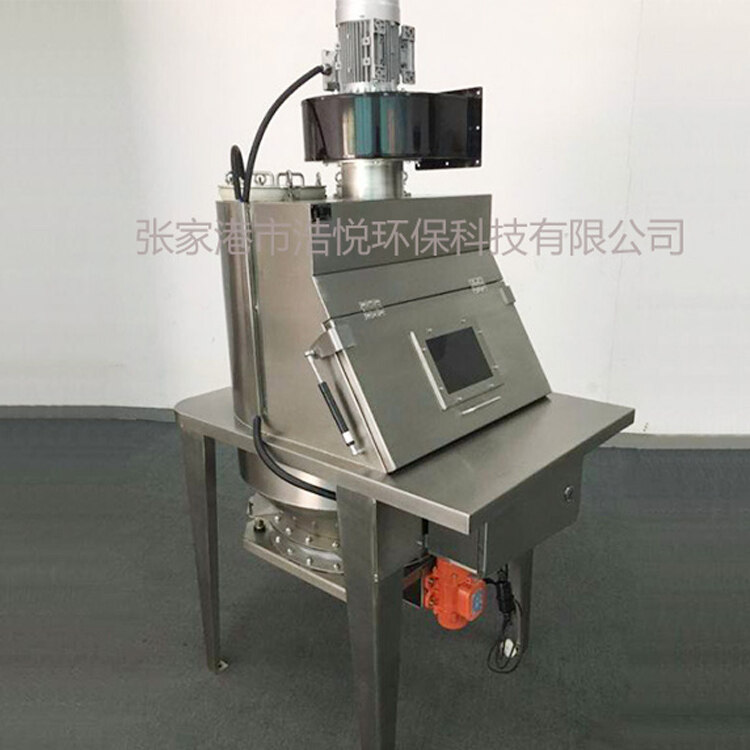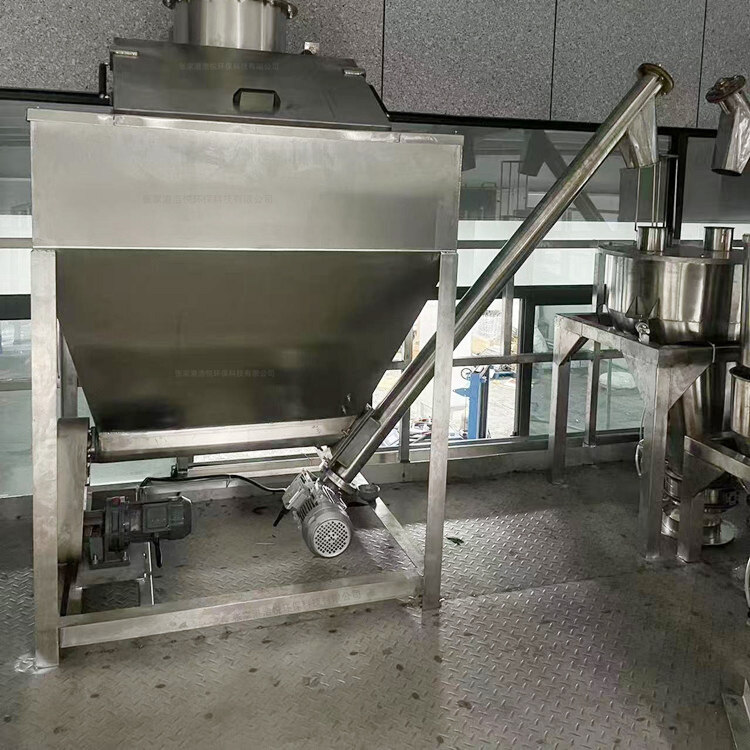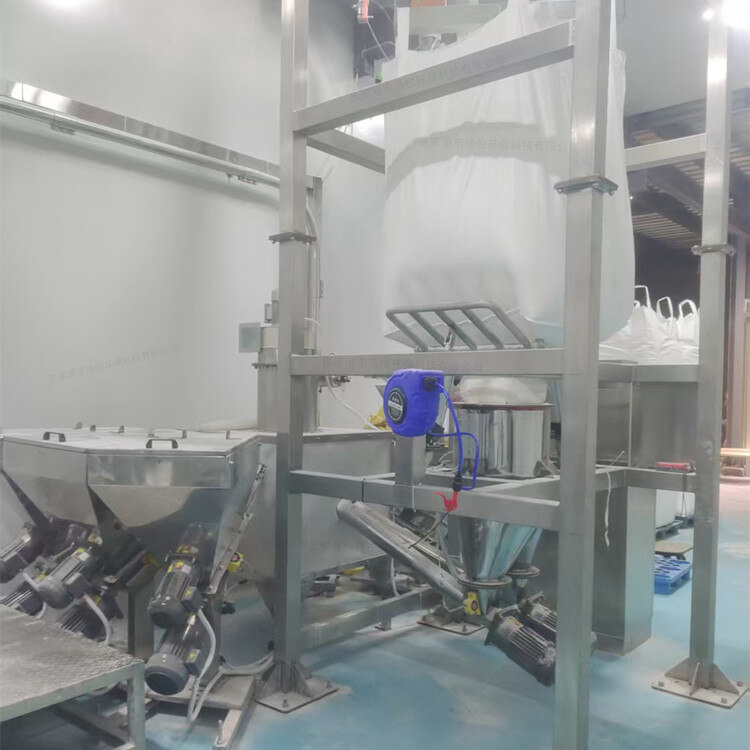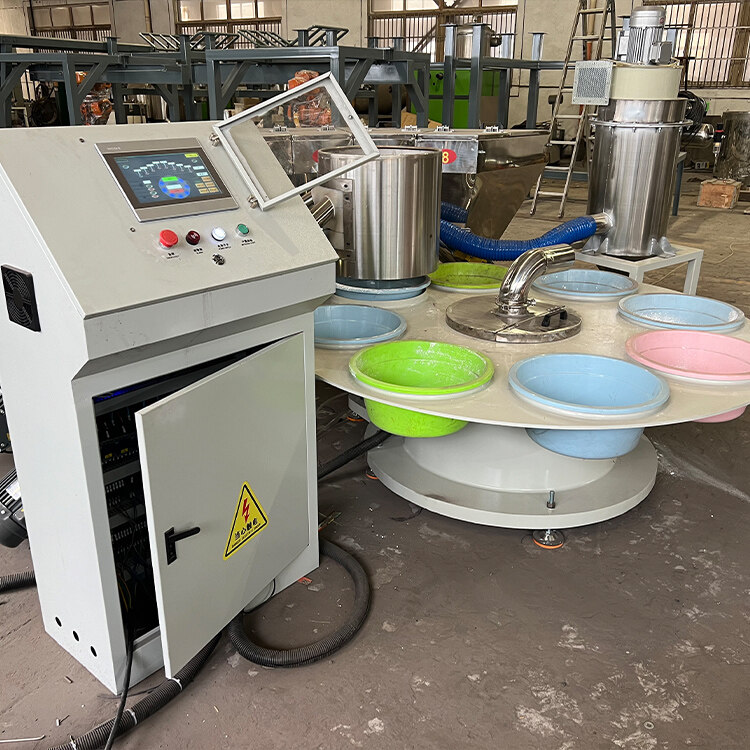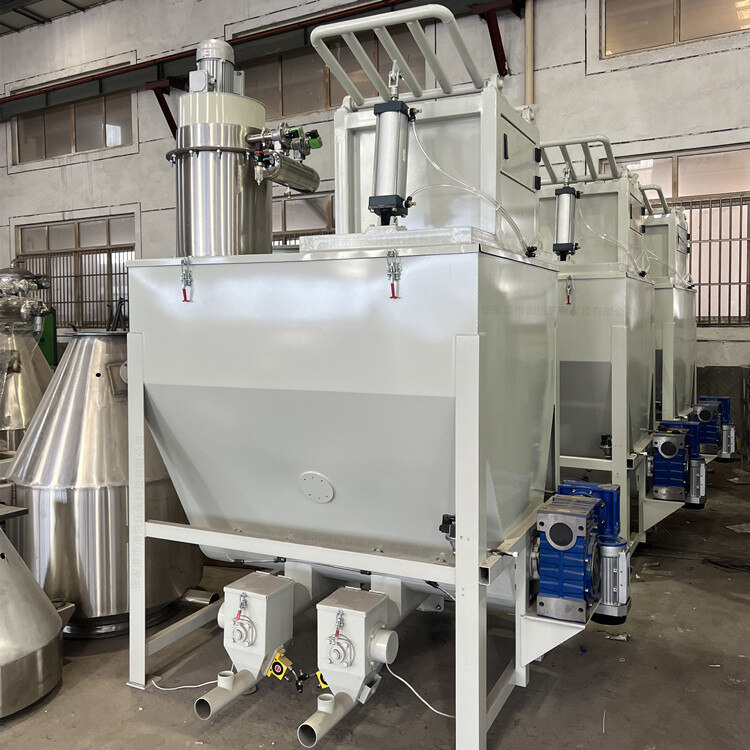- Introduction to automatic batching machine and fully automatic batching machine equipment
- The powder metering system tells you about the introduction of the mixing and drying machine
- 1000kg vacuum feeding machine
- Fully automatic small material batching system
- Research on Innovation of Automatic Weighing Machine Technology
- Design and operation of automatic batching system using PLC, industrial computer and frequency converter
Small bag dust-free feeding station
- Category:Feeding station
- Hits:113次
- Release Date:2025-06-30
- Share:
- Inquiry
- Details
In modern industrial production, especially in industries such as food, pharmaceuticals, and chemicals that have extremely high requirements for production environment and product quality, the feeding process of small bag materials often faces challenges such as dust flying, material waste, and cross contamination. The small bag dust-free feeding station has emerged, which achieves dust-free and efficient feeding of small packaging materials (such as bagged powders, granules, additives, etc.) through innovative design and advanced technology, becoming a key equipment to ensure product quality and improve production environment safety. The following will provide a comprehensive introduction to the small bag dust-free feeding station from the aspects of equipment structure, working principle, core advantages, application scenarios, and development trends.
1、 Equipment structure and composition
The small bag dust-free feeding station mainly consists of four core parts: material receiving unit, dust removal and purification unit, auxiliary operation unit, and control system. Each part works together to form a complete dust-free feeding system.
(1) Material receiving unit
This unit is the entry point for small bag materials, usually designed as an ergonomic operating window, which facilitates the unpacking and feeding operations of operators. The window is equipped with a quick sealing door, which adopts pneumatic or electric control to quickly close before and after material feeding, reducing dust overflow. There is a guide groove or vibrating hopper inside, which can guide the material to smoothly slide down to the conveying equipment below. The vibrating hopper uses vibration to quickly discharge the material, avoiding material residue and blockage, ensuring a smooth and efficient feeding process.
(2) Dust removal and purification unit
The dust removal and purification unit is the core module for achieving dust-free feeding, mainly composed of a negative pressure fan, a filtering device, and a dust collection bucket. The negative pressure fan generates a stable negative pressure environment (generally maintained at -500Pa to -1000Pa), and quickly inhales the generated dust during material unpacking and dispensing. The filtering device often uses efficient pulse bag dust collectors or filter cartridge dust collectors, with a filtration accuracy of over 99.9%, which can effectively intercept micron sized dust particles. The collected dust falls into the dust collection bucket, which has a quick detachable structure for regular cleaning and maintaining the continuous and efficient operation of the equipment. In addition, some high-end models are equipped with secondary dust removal devices to further enhance the dust removal effect and ensure that the emitted air meets environmental standards.
(3) Auxiliary operating unit
The auxiliary operation unit includes a lighting system, anti-static device, and material storage platform. The lighting system provides sufficient and uniform light for the operating area, making it convenient for operators to observe the material placement clearly; The anti-static device eliminates static electricity on the surface of materials and equipment through grounding wires and anti-static coatings, preventing dust accumulation caused by electrostatic adsorption and avoiding safety hazards caused by static electricity, especially suitable for feeding flammable and explosive materials; The material temporary storage platform can temporarily store small bags of materials to be thrown, optimize the operation process, and improve work efficiency.
(4) Control system
The control system is based on PLC (Programmable Logic Controller) as the core, paired with a touch screen human-machine interaction interface (HMI). The operator can set parameters such as the speed of the negative pressure fan, the frequency and time interval of the pulse cleaning through the touch screen. The system monitors the real-time operation status of equipment, such as the current of the fan, the pressure difference of the filtering device, etc. Once an abnormality occurs (such as fan failure or filter blockage), it immediately issues an audible and visual alarm and automatically takes corresponding protective measures, such as stopping the machine or switching to backup equipment. In addition, the control system can also record the operating data of the equipment, which is convenient for later maintenance and production management analysis.
2、 Working principle and process
After the operator places the small bag material on the material storage platform, they open the sealed door of the material receiving unit and place the small bag material above the guide groove or vibrating hopper for unpacking operation. At this point, the negative pressure fan of the dust removal and purification unit is already in operation. Under the action of negative pressure, the dust generated during the unpacking process is quickly sucked into the filtration device. The material falls into the conveying equipment below (such as screw conveyor, belt conveyor) through the diversion groove or vibrating hopper to complete the feeding. During the feeding process, the negative pressure fan continues to operate to maintain a negative pressure environment in the feeding area and ensure that dust does not leak out. After a feeding is completed, the operator closes the sealing door, and the system regularly starts the pulse dust cleaning function according to the set program. Compressed air is instantly sprayed into the filtering device through the pulse valve to remove the dust attached to the surface of the filter bag or filter cartridge and fall into the dust collection bucket. The entire process has a high degree of automation, effectively reducing manual intervention and minimizing the harm of dust to operators and pollution to the production environment.
3、 Core technological advantages
(1) Efficient dust removal and clean production
The small bag dust-free feeding station achieves instant capture and purification of dust through a stable negative pressure environment and efficient filtration device, keeping the dust concentration in the feeding area at an extremely low level, ensuring a clean production environment, and meeting the strict requirements of industries such as food and pharmaceuticals for the production environment, such as complying with GMP (Good Manufacturing Practice), HACCP (Hazard Analysis and Critical Control Points) and other standards.
(2) Precise control to reduce waste
The design of the diversion groove and vibrating hopper ensures complete material feeding and reduces residue; Accurate negative pressure control avoids excessive suction of materials into the dust removal system due to excessive suction, thereby reducing material waste and saving production costs for enterprises. According to statistics, the use of small bag dust-free feeding stations can reduce material waste rates by 30% to 50%.
(3) Easy to operate, safe and reliable
Ergonomic design and intelligent control system reduce the labor intensity of operators, making operation simple and easy to understand. At the same time, safety measures such as anti-static, overload protection, emergency shutdown, etc. comprehensively ensure the personal safety of operators and the stable operation of equipment.
(4) Flexible adaptation, widely applicable
Equipment components made of different materials (such as stainless steel, food grade plastic) can be customized according to different material characteristics (such as particle size, flowability, corrosiveness) and production needs, to adapt to various feeding scenarios of small bag materials, such as bagged flour, additives, pharmaceutical raw materials, chemical reagents, etc.
4、 Application scenarios
(1) Food processing industry
In the production process of food additives, condiments, baking materials, etc., the small bag dust-free feeding station is used to accurately put sugar powder, salt, essence, flour and other materials in small packages, so as to avoid dust pollution of food materials, ensure food safety and product quality, improve the working environment of the workshop, and enhance the working comfort of employees.
(2) Pharmaceutical industry
Pharmaceutical production has extremely high requirements for environmental cleanliness and material purity. The small bag dust-free feeding station can be used for the feeding of small packaging drug raw materials and auxiliary materials in sterile workshops to prevent cross contamination, ensure that the drug production process complies with GMP standards, and guarantee drug quality and safety.
(3) Chemical industry
For small packaging reagents, additives and other materials in chemical production, small bag dust-free feeding stations can effectively control dust flying, avoid safety accidents and environmental pollution caused by flammable, explosive or toxic and harmful dust, and improve the accuracy of material feeding to ensure the quality stability of chemical products.
(4) Other industries
In industries such as electronic materials and new energy materials, small bag dust-free feeding stations can be used for dust-free feeding of small packaging powder materials (such as lithium battery cathode materials and electronic grade silicon powder), meeting the production needs of high material cleanliness and environmental requirements.
5、 Development Trends
In the future, small bag dust-free feeding stations will develop towards intelligence, integration, and energy conservation. In terms of intelligence, the introduction of IoT technology enables remote monitoring and fault warning of devices, and optimizes device operating parameters through big data analysis; In terms of integration, it deeply integrates with the enterprise's MES (Manufacturing Execution System) and ERP (Enterprise Resource Planning) systems to achieve collaboration in production planning, material management, and feeding operations; Energy saving is reflected in the use of efficient and energy-saving fans and filter materials, reducing equipment operating energy consumption, optimizing system design, reducing compressed air consumption, and promoting green and sustainable development of the industry.


